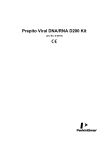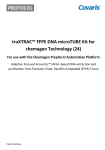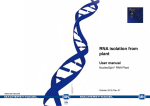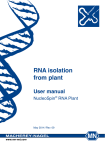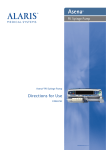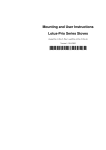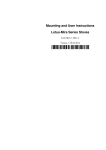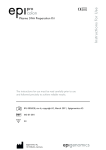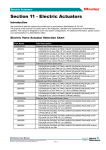Download English handbook article No. D-2021
Transcript
Prepito NA Body Fluid D200 Kit (art. No. D-2021) Symbols 180 Kit contains reagents for 180 preparations Refer to information given in the handbook V120222 Expiry date Lot number in vitro diagnostic medical device Temperature limitations D-2021 PerkinElmer chemagen Technologie GmbH Arnold-Sommerfeld-Ring 2 D-52499 Baesweiler Tel.: +49-2401-805500 Intended use With the Prepito NA Body Fluid D200 Kit nucleic acids can be isolated from different kinds of body fluids such as whole blood, plasma, serum, urine, liquor but also for different kind of swabs and feces suspensions for subsequent in vitro diagnostic purposes. The Kit has to be used with the chemagic Prepito-D. The product is intended for professional users such as technicians and physicians trained in molecular biology techniques. To minimize irregularities in diagnostic results, the product should always be used with an internal control as well as positive and negative controls throughout the process of sample preparation, sample amplification and detection according to the downstream assay used. Any diagnostic results generated using the sample preparation procedure in conjunction with any downstream diagnostic NAT assay should be interpreted with regard to other clinical or laboratory findings. V120222 Page 2 / 17 Content Symbols ................................................................................................................................................... 2 Intended use ............................................................................................................................................ 2 Functional principle.................................................................................................................................. 4 Quality control .......................................................................................................................................... 4 Product limitations/Choice of protocol ..................................................................................................... 4 Stability and storage ................................................................................................................................ 4 Protocol duration ..................................................................................................................................... 5 Typical yields (whole blood samples) ...................................................................................................... 5 Contents of the Kit unit (corresp. to 180 preparations from 200 µL sample material) ............................ 6 Safety....................................................................................................................................................... 8 Equipment and other material to be provided by the user .................................................................... 10 Purification Protocol using the chemagic Prepito-D .............................................................................. 10 Positioning of the Deep Well Plate and the chemagic Tip & Tube Rack .............................................. 10 Protocol Steps - Blood Samples (chemagic Prepito-D serial numbers 1 – 99)..................................... 11 Protocol Steps - Plasma Samples (chemagic Prepito-D serial numbers 1 – 99) .................................. 12 Protocol Steps - Blood Samples (chemagic Prepito-D serial numbers 100 and later).......................... 13 Protocol Steps - Plasma Samples (chemagic Prepito-D serial numbers 100 and later) ....................... 14 General remarks .................................................................................................................................... 15 UV Measurements ................................................................................................................................. 15 Troubleshooting ..................................................................................................................................... 16 V120222 Page 3 / 17 Functional principle The chemagic Prepito NA Body Fluid D200 Kit is based on chemagen’s proprietary magnetic bead technology platform. Cells or viruses in the sample material are lysed during the isolation process. The released nucleic acids bind to small magnetisable particles which are then magnetically separated from the sample material. During subsequent steps contaminations are removed and the purified nucleic acids are transferred into an elution medium. The automated sample processing by the chemagic Prepito-D excludes cross contamination and ensures a safe handling of infectious sample material. Quality control Each lot is tested for its defined specifications according to chemagen’s Quality Management System. Procedures that are not in accordance with this manual could cause inadequate results. Product limitations/Choice of protocol The Kit is designed for the use with different kinds of body fluids such as whole blood (fresh or frozen), plasma, serum, urine, liquor but also for different kinds of swabs and feces suspensions. Depending on the sample material different protocols have to be used: • Protocol [Body Fluid - Blood] for whole blood and sample material contaminated with whole blood. In the following protocol description these samples are named with the term “Blood Samples”. • Protocol [Body Fluid - Plasma] for other sample material as described above. In the following protocol description these samples are named with the term “Plasma Samples”. Body fluids can directly be used in aliquots of 200 µL per isolation. Transport media from swab samples can either be processed directly or the cells can be concentrated by a centrifugation step. In either case the processable volume per sample is 200 µL. Feces suspensions have to be centrifuged and 200 µL of the supernatant have to be used per isolation. The Kit is not intended for the use with tissue as sample material. The isolation efficiency with other types of sample material has not been determined. In some rare cases - especially with compromised blood (aged or improperly stored) - colored eluates can be observed. Colored eluates may interfere with UV measurements and may affect results in subsequent downstream applications. Stability and storage Expiry dates are stated on the box and the single components of the kit. Do not use any components of the kit beyond the expiration date. All kit components can be stored at room temperature. Lysis Buffer 1 (plasma) and Poly(A) RNA Buffer have to be stored in the dark. Lysis Buffer 1 may form a precipitate upon storage. If necessary, warm to approximately 55 °C to redissolve. Precipitates in the Poly(A) RNA buffer can be redissolved at room temperature. After reconstitution Proteinase K solution and Poly(A) RNA solution have to be stored at 4 °C. The solutions can be used for 6 weeks. For long term storage we recommend aliquoting the Proteinase K solution and the Poly(A) RNA solution and storing at –20 °C. V120222 Page 4 / 17 Protocol duration The length of the purification protocol is 75 min. Typical yields (whole blood samples) From 200 µL whole blood 4 – 8 µg DNA can be isolated. The obtained yields depend on the number of leukocytes in the sample material and vary from specimen to specimen. V120222 Page 5 / 17 Contents of the Kit unit (corresp. to 180 preparations from 200 µL sample material) 1. Magnetic Beads 30 mL 2. Lysis Buffer 1 (blood)*: 95 mL Guanidine hydrochloride 15 – 30 %, Triton X-100 1 – 3 % 3. Lysis Buffer 1 (plasma): 2 x 48 mL Guanidine thiocyanate 43 – 50 % 4. Binding Buffer 2 (blood)*: 210 mL Tris-HCl-buffer, Sodium perchlorate 30 – 40 %, Ethanol 35 – 45 % 5. Binding Buffer 2 (plasma)*: 210 mL Tris-HCl-buffer, Sodium perchlorate 25 – 28 %, Ethanol 45 – 60 % 6. Wash Buffer 3*: 210 mL Tris-HCl-buffer, Guanidine hydrochloride 3 – 5 %, Sodium perchlorate 15 – 20 %, Ethanol 20 – 25 % 7. Wash Buffer 4*: 110 mL Tris-HCl-buffer, Sodium perchlorate 10 – 15 %, Ethanol 20 – 25 % 8. Wash Buffer 5*: 110 mL Ethanol 70 – 80 % 9. Wash Buffer 6*: 110 mL 10. Elution Buffer 7: 50 mL 10 mM Tris-HCl-buffer pH 8.0 11. Proteinase K: 2.0 mL 12. Poly(A) RNA: 2 x 350 µg 13. Poly(A) RNA Buffer: 2 x 440 µL 14. Disposable Tips: 180 V120222 Page 6 / 17 15. 2 mL Deep Well Plates: 15 16. 0.75 mL Reaction Tubes: 360 17. 0.75 mL Caps: 180 *included in the chemagic 8-Pack V120222 Page 7 / 17 Safety To avoid injuries while working with the kit components, always wear safety glasses, disposable gloves, and protective clothing. For detailed information, please refer to the according material safety data sheet (MSDS). Reagent 1: Magnetic Beads, no hazardous ingredients Reagent 2: Lysis Buffer 1 (blood) Guanidine hydrochloride CAS No.50-01-1 EC No. 200-002-3 Xn R22-36/38, S2-22 Triton X-100 CAS No. 9002-93-1 EC No. R22-41 S24-26-39 Reagent 3: Lysis Buffer 1 (plasma) Guanidine thiocyanate, CAS No. 593-84-0, EC No. 209-812-1, Xn R20/21/22-32-52/53, S13-61 Reagent 4: Binding Buffer 2 (blood) Sodium Perchlorate CAS No.7601-89-0 EC No.231-511-9, Xn R9-22, S13-22-27 Ethanol CAS No.64-17-5 EC No.200-578-6, F R10, S7-16 Reagent 5: Binding Buffer 2 (plasma) Sodium Perchlorate CAS No.7601-89-0 EC No.231-511-9, Xn R9-22, S13-22-27 Ethanol CAS No.64-17-5 EC No.200-578-6, F R10 Reagent 6: Wash Buffer 3 Ethanol CAS No.64-17-5 EC No.200-578-6, F R10, S7-16 Guanidin-Hydrochlorid CAS No.50-01-1 EC No. 200-002-3 Xn R22-36/38, S2-22 Sodium Perchlorate CAS No.7601-89-0 EC No.231-511-9, Xn R9-22, S13-22-27 Reagent 7: Wash Buffer 4 Ethanol CAS No.64-17-5 EC No.200-578-6, F R10, S7-16 Sodium Perchlorate CAS No.7601-89-0 EC No.231-511-9, Xn R9-22, S13-22-27 Reagent 8: Wash Buffer 5 Ethanol CAS No.64-17-5 EC No.200-578-6, F R10, S7-16 Reagent 9: Wash Buffer 6, no hazardous ingredients Reagent 10: Elution Buffer 7, no hazardous ingredients V120222 Page 8 / 17 Reagent 10: Proteinase K Protease CAS No.39450-01-6 EC No.254-457-8, Xn R36/37/38-42/43 S22-2426 36/37/39 46 EC 1272/2008: H315 H317 H319 H334 H335 P261 P280 P285 P305+P351+P338 P321 P405 Reagent 12: Poly(A) RNA, no hazardous ingredients Reagent 13: Poly(A) RNA Buffer Guanidine-Thiocyanate, CAS No.593-84-0, EC No.209-812-1, Xn R20/21/22-32-52/53, S13-61 V120222 Page 9 / 17 Equipment and other material to be provided by the user chemagic Prepito-D, RNAse-free water, disposable gloves, pipette and pipette tips with aerosol barrier (ensure that all used material is RNase free). Purification Protocol using the chemagic Prepito-D The protocol is suitable for up to 12 samples in parallel (see protocol steps below). Detailed instructions for the use of the chemagic Prepito-D are given in the corresponding user manual. Before you start: • Check all kit components for integrity. In case of damages contact your supplier. • Connect the tubes according to their numbering to the respective counterparts at the chemagic 8-Pack. Remove the lids from the individual buffer bottles in the chemagic 8-Pack and pierce the septum with the spike at the end of the tube. Place the chemagic 8-Pack upside down on the reagent holder. • Dissolve the lyophilized Proteinase K in RNAse-free water (see instruction on the tube) and Poly(A) RNA in 440 µL Poly(A) RNA Buffer per tube. Positioning of the Deep Well Plate and the chemagic Tip & Tube Rack The following scheme shows the orientation of the 96 Deep Well Plate (DWP) and the chemagic Tip and Tube Rack 96 - Deep Well Plate Tip & Tube Rack. For detailed information see protocols steps. V120222 Pos. 4 Pos. 3 Disposable Tips Pos. 2 0.75 mL reaction tubes with 150 µL Magnetic Beads Pos. 1 0.75 mL reaction tubes with 50 - 100 µL Elution Buffer second row for Disposable Tips; ! not used in this protocol ! Page 10 / 17 Protocol Steps - Blood Samples (chemagic Prepito-D serial numbers 1 – 99) 1. Switch on the chemagic Prepito-D and wait for the self test to finish. 2. Press [change protocol]. 3. Select the Prepito NA Body Fluid D200 Kit protocol by pressing [Body Fluid/Blood]. 4. Enter the access code [3005] for authorization and confirm by pressing [enter]. 5. Confirm the selection of the correct protocol by pressing [enter]. 6. Read the protocol information in the appearing information screen. Confirm by pressing [continue]. 7. Select the sample positions and confirm by pressing [continue]. 8. Enter the kit barcode with the barcode scanner and confirm by pressing [ok]. 9. For the registration of the samples and storage tubes press [yes] and follow the instructions on the touch screen panel to enter the according barcodes. 10. Prepare the chemagic Tip & Tube Rack with the required materials. Place one 0.75 mL reaction tube filled with 50 - 100 µL Elution Buffer (position 1), one 0.75 mL reaction tube filled with 150 µL of Magnetic Beads (position 2) and one Disposable Tip (position 3) for each sample into positions according to the sample positions. Shake the Magnetic Bead solution vigorously until all Magnetic Beads are completely ! suspended. An incomplete resuspension of the Magnetic Bead solution could cause a decreased yield of extracted nucleic acids. 11. For the processing of sample material contaminated with blood add 4 µL Poly(A) RNA solution and 10 µL Proteinase K solution into the sample position of the Deep Well Plate (DWP; see section above “Positioning of Deep Well Plate and chemagic Tip & Tube Rack”). ! Use Poly(A) RNA and Proteinase K solutions only with samples contaminated with blood. Don’t use Proteinase K and Poly(A) RNA for the preparation of whole blood material. 12. Add 200 µL sample material into the sample position of the Deep Well Plate (see section above “Positioning of Deep Well Plate and chemagic Tip & Tube Rack”). 13. An information screen indicates the previously selected sample positions. Ensure that the sample positions in the DWP correspond to the selected positions. Place the DWP on its default position on the tracking system and press [continue]. 14. Place the chemagic Tip & Tube Rack on its default position on the tracking system. Check the accurate fit of the DWP and chemagic Tip & Tube Rack and lock both by closing the safety latch. 15. Close the front door and immediately start the automated isolation process by pressing [start]. V120222 Page 11 / 17 Protocol Steps - Plasma Samples (chemagic Prepito-D serial numbers 1 – 99) 1. Switch on the chemagic Prepito-D and wait for the self test to finish. 2. Press [change protocol]. 3. Select the Prepito NA Body Fluid D200 Kit protocol by pressing [Body Fluid/Plasma]. 4. Enter the access code [3005] for authorization and confirm by pressing [enter]. 5. Confirm the selection of the correct protocol by pressing [enter]. 6. Read the protocol information in the appearing information screen. Confirm by pressing [continue]. 7. Select the sample positions and confirm by pressing [continue]. 8. Enter the kit barcode with the barcode scanner and confirm by pressing [ok]. 9. For the registration of the samples and storage tubes press [yes] and follow the instructions on the touch screen panel to enter the according barcodes. 10. Prepare the chemagic Tip & Tube Rack with the required materials. Place one 0.75 mL reaction tube filled with 50 - 100 µL Elution Buffer (position 1), one 0.75 mL reaction tube filled with 150 µL of Magnetic Beads solution (position 2) and one Disposable Tip (position 3) for each sample into positions according to the sample positions. Shake the Magnetic Bead solution vigorously until all Magnetic Beads are completely ! suspended. An incomplete resuspension of the Magnetic Bead solution could cause a decreased yield of extracted nucleic acids. 11. Add 10 µL of Proteinase K and 4 µL Poly(A) RNA solutions to each well of the Deep Well Plate (DWP) defined as sample well (see above section “Positioning of the Deep Well Plate and the chemagic Tip & Tube Rack”). 12. Add 450 µL Lysis Buffer (plasma) and 200 µL sample material to each sample well prefilled with Proteinase K and Poly(A) RNA solutions. 13. An information screen indicates the previously selected sample positions. Ensure that the sample positions in the DWP correspond to the selected positions. Place the DWP on its default position on the tracking system and press [continue]. 14. Place the chemagic Tip & Tube Rack on its default position on the tracking system. Check the accurate fit of the DWP and chemagic Tip & Tube Rack and lock both by closing the safety latch. 15. Close the front door and immediately start the automated isolation process by pressing [start]. V120222 Page 12 / 17 Protocol Steps - Blood Samples (chemagic Prepito-D serial numbers 100 and later) 1. Switch on the chemagic Prepito-D and wait for the self test to finish. 2. Press [Change Protocol]. 3. Press [Body Fluid] in the Select Protocol Group window. 4. Select the Prepito NA Body Fluid D200 Kit protocol by pressing [BF Blood] and confirm by pressing [OK]. 5. Confirm the protocol selection in the Select Protocol Group window by pressing [OK]. 6. Enter the 4 digit access code [3005] for authorization and confirm by pressing [Enter]. 7. Press [Start Process]. 8. Read the protocol information in the appearing information screen and confirm by pressing [Continue]. 9. Select the sample positions and confirm by pressing [OK]. 10. Enter the kit barcode with the barcode scanner and confirm by pressing [OK]. 11. For the registration of the samples and the storage tubes press [Yes] and follow the instructions on the touch screen panel to enter the according barcodes. 12. Prepare the chemagic Tip & Tube Rack with the required materials. Place one 0.75 mL reaction tube filled with 50 - 100 µL Elution Buffer (position 1), one 0.75 mL reaction tube filled with 150 µL of Magnetic Beads (position 2) and one Disposable Tip (position 3) for each sample into positions according to the sample positions. Shake the Magnetic Bead solution vigorously until all Magnetic Beads are completely ! suspended. An incomplete resuspension of the Magnetic Bead solution could cause a decreased yield of extracted nucleic acids. 13. For the processing of sample material contaminated with blood add 4 µL Poly(A) RNA solution and 10 µL Proteinase K solution into the sample position of the Deep Well Plate (DWP, see section above “Positioning of Deep Well Plate and chemagic Tip & Tube Rack”). ! Use Poly(A) RNA and Protease solutions only with samples contaminated with blood. Don’t use Proteinase K and Poly(A) RNA for the preparation of whole blood material. 14. Add 200 µL sample material into the sample position of the Deep Well Plate (see section above “Positioning of Deep Well Plate and chemagic Tip & Tube Rack”). 15. An information screen indicates the previously selected sample positions. Ensure that the sample positions in the DWP correspond to the selected positions. Place the DWP on its default position on the tracking system and press [Continue]. 16. Place the chemagic Tip & Tube Rack on its default position on the tracking system. Check for accurate fit of the DWP and chemagic Tip & Tube Rack and lock both by closing the safety latch. 17. Close the front door and start the automated isolation process by pressing [Start] immediately. V120222 Page 13 / 17 Protocol Steps - Plasma Samples (chemagic Prepito-D serial numbers 100 and later) 1. Switch on the chemagic Prepito-D and wait for the self test to finish. 2. Press [Change Protocol]. 3. Press [Body Fluid] in the Select Protocol Group window. 4. Select the Prepito NA Body Fluid D200 Kit protocol by pressing [BF Plasma] and confirm by pressing [OK]. 5. Confirm the protocol selection in the Select Protocol Group window by pressing [OK]. 6. Enter the 4 digit access code [3005] for authorization and confirm by pressing [Enter]. 7. Press [Start Process]. 8. Read the protocol information in the appearing information screen and confirm by pressing [Continue]. 9. Select the sample positions and confirm by pressing [OK]. 10. Enter the kit barcode with the barcode scanner and confirm by pressing [OK]. 11. For the registration of the samples and the storage tubes press [Yes] and follow the instructions on the touch screen panel to enter the according barcodes. 12. Prepare the chemagic Tip & Tube Rack with the required materials. Place one 0.75 mL reaction tube filled with 50 - 100 µL Elution Buffer (position 1), one 0.75 mL reaction tube filled with 150 µL of Magnetic Beads solution (position 2) and one Disposable Tip (position 3) for each sample into positions according to the sample positions. Shake the Magnetic Bead solution vigorously until all Magnetic Beads are completely ! suspended. An incomplete resuspension of the Magnetic Bead solution could cause a decreased yield of extracted nucleic acids. 13. Add 10 µL of Proteinase K and 4 µL Poly(A) RNA solutions to each well of the Deep Well Plate (DWP) defined as sample well (see above section “Positioning of the Deep Well Plate and the chemagic Tip & Tube Rack”). 14. Add 450 µL Lysis Buffer (plasma) and 200 µL sample material to each sample well prefilled with Proteinase K and Poly(A) RNA solutions. 15. An information screen indicates the previously selected sample positions. Ensure that the sample positions in the DWP correspond to the selected positions. Place the DWP on its default position on the tracking system and press [Continue]. 16. Place the chemagic Tip & Tube Rack on its default position on the tracking system. Check for accurate fit of the DWP and chemagic Tip & Tube Rack and lock both by closing the safety latch. 17. Close the front door and start the automated isolation process by pressing [Start] immediately. V120222 Page 14 / 17 General remarks It is strongly recommended to use the extracted nucleic acids immediately for amplification. If nucleic acid extracts cannot be used for amplification directly after preparation, the nucleic acid extracts can be kept at -20 °C or preferably at -70 °C for up to one month or one year respectively. The Elution Buffer included in this kit is 10 mM Tris-HCl pH 8.0. UV Measurements In some cases you may find traces of magnetic beads left in the eluate. Such particles will not interfere with PCR and most downstream applications but may increase the background in UV measurements. In such a case, prior to UV analysis, we recommend an additional separation step using a manual separator (e.g. chemagic Stand 2x12, art. No: 300) in order to separate any traces of particles. V120222 Page 15 / 17 Troubleshooting Problem Possible Cause Recommendation/Solution Incorrect amount of Magnetic Beads added Resuspend the Magnetic Beads well before adding to the lysate Insufficient lysis Add the correct volume of lysis buffer Buffers in the chemagic 8-Pack are not connected to the machine *Connect the buffers in the chemagic 8-Pack to the machine The chemagic 8-Pack is not positioned in the right manner on the reagent holder *Place the chemagic 8-Pack in the correct position on the reagent holder Tubes contain air after connecting the chemagic 8-Pack to the machine *Fill the tubes completely using the manual priming function Buffers in the chemagic 8-Pack are empty *Change the chemagic 8-Pack. Don’t use the chemagic 8-Pack for more than the indicated preparations Buffers of the chemagic 8-Pack are not connected in the right manner to the chemagic Prepito-D *Check/correct the connections between the chemagic Prepito-D and the chemagic 8-Pack Irregular dispensing of the buffers *Check the calibration of the pumps Incorrect amount of Magnetic Beads added Resuspend the Magnetic Beads well before adding to the lysate Buffers in the chemagic 8-Pack are not connected to the machine *Connect the buffers in the chemagic 8-Pack to the machine The chemagic 8-Pack is not positioned in the right manner on the reagent holder *Place the chemagic 8-Pack in the correct position on the reagent holder Tubes contain air after connecting the chemagic 8-Pack to the machine *Fill the tubes completely using the manual priming function Buffers in the chemagic 8-Pack are empty *Change the chemagic 8-Pack. Don’t use the chemagic 8-Pack for more than the indicated preparations Buffers of the chemagic 8-Pack are not connected in the right manner to the chemagic Prepito-D *Check/correct the connections between the chemagic Prepito-D and the chemagic 8-Pack Irregular dispensing of the buffers *Check the calibration of the pumps Blood samples are not mixed thoroughly Mix the blood samples thoroughly Quotient of absorption A260/A280 to low Traces of Magnetic Beads in the elution solution falsify the result of the measurement Remove remaining traces of Magnetic Beads using a manual separator (e.g. chemagic Stand 2x12, art. No: 300) Contaminated or inactive Proteinase K Visible microbial growth in Proteinase K solution Use sterile water for resuspension of the Proteinase K Low detection sensitivity for positive controls and/or target nucleic acid Insufficient yields of DNA (blood samples) V120222 Page 16 / 17 Problem Contaminated or inactive Proteinase K Possible Cause Incorrect storage of the Proteinase K solutions Recommendation/Solution Store Proteinase K solution at 4 °C; do not use the solutions longer than 6 weeks Store aliquots at –20 °C Avoid thawing-freezing cycles Subsequent detection reactions are not working optimally Red eluates from plasma or serum samples/low detection sensitivity Brown or red eluates from whole blood samples Malfunction of the instrument Insufficient amount of nucleic acids used for the detection reaction Too much nucleic acids used for the detection reaction Determine the concentration of nucleic acids via UV measurement and use an adequate amount in subsequent reactions Traces of erythrocytes in the plasma or serum samples Avoid to carry over erythrocytes during the preparation of plasma or serum In some rare cases - especially with compromised blood (aged or improperly stored) - colored eluates can be observed Don’t use improperly stored blood Don’t use Proteinase K and Poly(A) RNA for the preparation of whole blood material Blood was prepared with Lysis Buffer 1 (plasma) and the [Body Fluid - Plasma] protocol Ensure that blood samples are prepared with the [Body Fluid - Blood] protocol e.g. mechanical, electrical or electronical problems Contact chemagen or your local supplier *detailed information is given in the manual of the chemagic Prepito-D V120222 Page 17 / 17

















